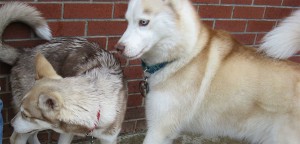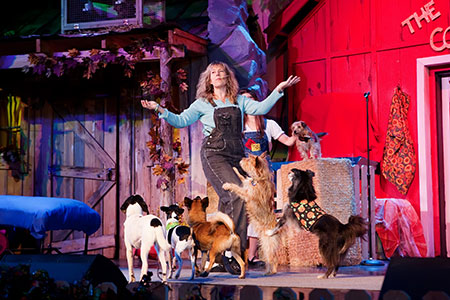An Intervention is in Order: Canine Bullies in a Multiple Dog Household
It used to be called being dominant, and in some circles it still is, sadly. But this behavior is actually simple bullying. As with humans, bullying is always inappropriate. It can arise for several reasons, among them insecurity, anxiety, juvenile behavior in young adults and puppies and just plain old bad manners.
Being a bully has nothing to do with the breed of the dog who is the bully. Any breed can be a bully. Puppies who are very exuberant and having difficulty learning impulse control are prime targets to become a bully when allowed unchecked in a multiple dog household. Possessing a good temperament otherwise will not prevent a puppy from becoming a bully. One can be a canine bully and be a nice dog otherwise, which is where this act typically differs with human bullies.
Those who have children and who are raising them with limits and guidelines that are parentally enforced will understand this advice immediately. Dogs are not furry children (see here for more on that) but they are equally in need of structure and knowing what is appropriate or not. It is very important to set limits and provide said structure.
We as humans are not meant to be “pack leaders”; dogs know that we are a different species; I can assure you of this! What we are meant to be, however, is the human who provides for all their needs. This includes the need for clearly communicated boundaries, guidelines, information and reward incentives as well as non-scary consequences for infractions of said rules.
Boundaries should include, but are not limited to, preventing/intervening with these inappropriate activities:
• “nagging” any other dog for any reason.
• sniffing body parts of another dog for lengthy periods of time (especially when the receiver is obviously uncomfortable)
• insistence on play when the other party is not interested
• ”pacing” another dog (physically matching their walking pace outside of the realm of interactive play)
• “walk bys” of another dog (seemingly benign walking by another dog with the intent of intimidation)
• body slamming another dog in greeting
• being “in your face” intrusive without an invitation to do so
• any posturing meant to intimidate.
The list is longer than the above but it’s nearly impossible to include every scenario. Multiple dog households parents really owe it to themselves and their charges to educate themselves on dog body language and appropriate play. There are several ways to do this. There are a few well done books available that have great information on body language as well as the go-to DVD on this subject by Sarah Kalnajs. The newest option for this is Lili Chin’s fabulous “Doggie Body Language“. Another option is to attend organized playgroups that are supervised by behavior professionals familiar with both positive reinforcement training and dog body language. Watching the interaction through their eyes can help with viewing your own crew more clearly. You get to see what needs interrupted and what doesn’t.
Positive never means permissive when inappropriate behavior is being demonstrated. It is completely possible to intervene appropriately without causing fear or using force. Human to dog body language is useful to learn for this practice. When your crew respects your ability to set boundaries in a clear and concise manner without using an iron fist, they feel safe and secure responding to your cues to cease and desist.
Often the simple act of clearing one’s throat and throwing a pointed look at the offender will be enough to interrupt poor choices in an otherwise well structured household. Quietly placing your body between the two or more dogs involved can cause an immediate deflection. This is called splitting and dogs use it too. Using what I call “the mom stance”, hands on hips with a disappointed look on your face, can stop an incident if implemented soon enough. Well marked and timed Time Outs are worth the effort to learn to implement correctly. Read here for more on that.
Those who follow my blog, know that I have a puppy in my household at present (at the time of this original writing). Puppies are rude until taught otherwise. Sometimes I intervene, sometimes another dog intervenes appropriately for me. This can be permitted if you know what is appropriate in a canine correction and what isn’t. For example Kenzo, the puppy, stole Trent’s bone and Trent did not stop him. So I retrieved it for him. It took three retrievals and a “mom” look to eliminate this behavior on this particular day. A fourth attempt on Kenzo’s part would have resulted in a time out. I give three tries on benign behavior.
But later the same evening, Kenzo tried on his big boy pants and made a posturing move towards Trent. I did not have time to intervene nor did Trent have time to object because Siri intervened for both of us, immediately and quite correctly. She split between them with her body immediately and roared a bit at Kenzo, quite appropriately, without hurting him. She did, however, make enough of an impression (based on the size of his eyes!) that I am certain that he won’t try that again soon. So while you cannot simply allow the dogs to work it out among themselves, you can periodically rely on dogs who have appropriate mediation skills.
So it is possible to have a multiple dog household with several strong personalities, without having strong conflict, if you learn how to intervene when appropriate. One of the easiest ways to help non-professionals understand how early on it can be necessary to step in is to equate what is happening to toddlers doing an equivalent behavior. If your two year old was shoving your three year old or vice versa, are you going to wait for them to ‘work it out on their own”? I certainly hope not! Don’t allow those kinds of decisions to be made in your canine household either and all will flow much more smoothly!
Posted in: Projects
Leave a Comment (128) →




